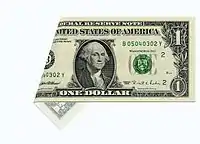Currency bill tracking
Currency bill tracking is the process (usually facilitated by any one of a number of websites set up for the purpose) of tracking the movements of banknotes, similar to how ornithologists track migrations of birds by ringing them. Currency bill tracking sites can track currency among the users of that website. A user may register a bill by entering its serial number, and if someone else has already registered the bill, then the "route" of the bill can be displayed.

Some bill tracking sites encourage marking before spending, whereas others do not. This usually depends on the laws of the country issuing the currency.
The most popular currencies for currency tracking are the Euro, the United States Dollar (USD), and the Canadian Dollar (CAD).
Background and legal status
Originally beginning in the United States in the mid-1990s, the phenomenon or hobby of currency tracking quickly spread first to Canada and then beyond. Especially with the Euro bill tracking, trackers have taken on a much more competitive nature and have formed communities within their respective sites. Many successful sites incorporate some sort of social media, either through site specific unique techniques, or through outside popular social media sites. In the Eurozone because multiple countries having adopted the Euro, this easily leads to competition between trackers in different countries; in the United States competition plays out at the state or county level; and in Canada, at the provincial level.
Marking bills in Canada with ink or rubber stamp is not illegal. In the United States, marking bills is illegal if there is intent to render the bill "unfit to be re-issued"; however, this is rarely enforced and only a fine is faced, if convicted. Marking is widespread in both countries. In the Eurozone marking is not universal, and varies by region. The European Central Bank considers the marking of bills (as well as the destruction of them) to be legal and not exclusive to governments.[1]
Popular currency bill tracking websites
Some of the most popular websites for bill tracking include the following:
America
- Where's George?, began in December 1998, was the first site to start a currency bill tracking project and remains by far the most popular of the sites, with the number of bills entered reaching more than 294,782,100 worth $1,585,043,180 as of February 10, 2020. The site was created by Hank Eskin to track US Dollars and has led to the creation of many other bill tracking sites.[2]
- Where's Willy? for CAD (Canada). Despite the website starting up two years after Canadian Money Tracker, it is the most popular of the Canadian currency tracking sites.[3]
- TrackDollar, a clone of Where's George, run by someone else.[4]
Europe
- EuroBillTracker was started on January 1, 2002 to track euro banknotes. It is the largest of the euro tracking sites.[5]
- DoshTracker, launched in 2001 and relaunched in 2012, allows pound sterling banknotes to be tracked around the United Kingdom and abroad
Oceania
- The Money Tracker, started in March 2006, tracks Australian dollars as they circulate around Australia, and uses an interactive map of Australia. It allows users to enter the serial number of a note to find out where it has traveled, as well as receive future notification if the note is entered by another user. The site was inspired by a banknote tracking exhibit at The Tech Museum of Innovation in San Jose, California, USA.[6]
In popular culture
The act of tracking a $20 bill was the binding theme between various stories in the film Twenty Bucks.
A similar scheme to currency bill tracking – and said to be inspired by it – is BookCrossing, which tracks the movement of secondhand books which are marked and then "released into the wild".
In one episode of the Czechoslovak comic series Rychlé šípy, the boy club releases a marked 1 crown coin and then they track the coin through Czechoslovakia.
See also
References
- https://eur-lex.europa.eu/LexUriServ/LexUriServ.do?uri=CELEX:32010H0191:EN:HTML
- The Where's George Website
- The Where's Willy Website
- The TrackDollar website
- "eurobilltracker.com". eurobilltracker.com. January 1, 2002. Retrieved March 13, 2012.
- "Money Tracker: About". Retrieved July 13, 2011.